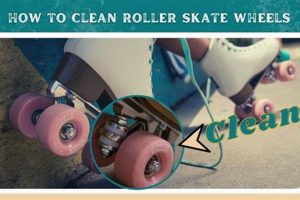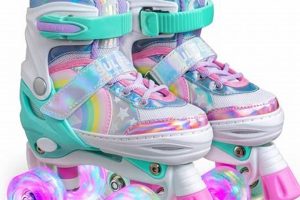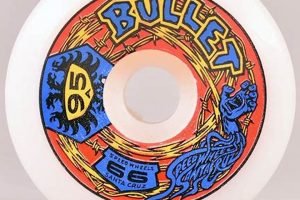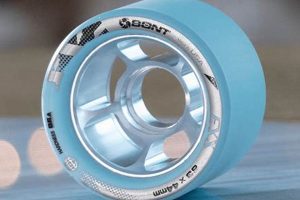This equipment, typically consisting of a boot or shoe attached to a frame holding a set of wheels, facilitates movement across smooth surfaces. The wheel component, often made of polyurethane, allows for rolling motion. Variations exist, including inline and quad designs, each offering distinct performance characteristics. For example, inline configurations, with wheels aligned in a single row, are often preferred for speed and agility, while quad configurations, with wheels arranged in pairs at the front and rear, provide greater stability.
The combination of foot support and rolling elements offers a recreational activity with physical and social benefits. Historically, this mode of locomotion evolved from early attempts to simulate ice skating on land, leading to continuous innovation in materials and design. Its enduring appeal lies in its accessibility, enabling users of various skill levels to engage in physical exercise, artistic expression, and competitive sports. Furthermore, the development of specialized versions has contributed to applications ranging from artistic skating to aggressive maneuvers performed in skate parks.
The following discussion will delve into specific types of this recreational equipment, including their construction, performance characteristics, and applications across different skating disciplines. Subsequent sections will also address maintenance considerations and safety protocols relevant to their use.
Tips for Optimizing Roller Skate and Wheel Performance
The following guidelines aim to improve the operational efficiency and longevity of roller skates through informed maintenance and usage practices.
Tip 1: Wheel Durometer Selection: Consider the durometer rating of the wheels. Lower durometer wheels (e.g., 78A) offer greater grip and are suitable for outdoor surfaces, while higher durometer wheels (e.g., 85A and above) provide less resistance and are optimal for smooth, indoor environments.
Tip 2: Bearing Maintenance: Regularly clean and lubricate bearings to reduce friction and maintain rolling speed. Disassemble the wheels, remove the bearings, clean them with a solvent, and apply a light lubricant designed for bearings.
Tip 3: Axle Tightness: Ensure that the axle nuts are tightened to a secure level, allowing the wheels to spin freely without excessive play. Over-tightening can restrict wheel rotation, while under-tightening can cause instability.
Tip 4: Wheel Rotation: Implement a wheel rotation schedule to promote even wear. Rotate the wheels based on the skating style and surface conditions. A common method is to swap the front and rear wheels on each skate, and then switch them diagonally.
Tip 5: Surface Assessment: Evaluate the skating surface before use. Abrasive surfaces can accelerate wheel wear. Choosing appropriate skating locations based on wheel type can extend the lifespan of the equipment.
Tip 6: Boot and Frame Integrity: Periodically inspect the boot and frame for any signs of damage or wear. Cracks or loose components can compromise safety and performance. Tighten any screws or bolts to ensure stability.
Tip 7: Proper Storage: Store the roller skates in a dry, cool environment away from direct sunlight. Exposure to extreme temperatures or moisture can degrade the wheels and bearings.
Adhering to these recommendations will contribute to enhanced performance, extended equipment lifespan, and a safer skating experience.
The subsequent sections will elaborate on specific maintenance procedures and safety considerations to maximize the benefits derived from utilizing roller skates and their components.
1. Material Composition
The material composition of roller skate components, particularly the wheels, significantly influences performance, durability, and rider experience. Wheel materials directly affect grip, speed, wear resistance, and the overall suitability of the skates for specific surfaces and skating styles.
- Polyurethane Properties
Polyurethane (PU) is the predominant material used in roller skate wheel manufacturing. Its versatility allows for tailoring specific characteristics through variations in its formulation. Factors such as rebound, abrasion resistance, and flexibility are determined by the type of PU used. High-rebound PU provides enhanced energy return, leading to increased speed and efficiency. Abrasion-resistant PU extends wheel lifespan by minimizing wear from contact with rough surfaces. Flexible PU offers superior grip and shock absorption.
- Durometer Impact
Durometer, a measure of a material’s hardness, is a critical specification for roller skate wheels. It directly affects the wheel’s performance characteristics. Softer wheels (lower durometer values) offer enhanced grip and are suitable for rough or outdoor surfaces, providing greater shock absorption and control. Harder wheels (higher durometer values) provide less friction and are better suited for smooth, indoor surfaces, facilitating higher speeds and more efficient rolling.
- Core Materials
The core, or hub, of a roller skate wheel provides structural support and influences wheel performance. Cores are typically made of rigid materials like nylon, polypropylene, or aluminum. Aluminum cores offer increased stiffness and responsiveness, transferring energy efficiently for enhanced speed and control. Nylon or polypropylene cores are lighter and can provide greater shock absorption, making them suitable for recreational or artistic skating.
- Bearing Seat Precision
The precision of the bearing seat within the wheel core is critical for bearing alignment and smooth rolling. Accurate bearing seats ensure that the bearings are properly seated and aligned, minimizing friction and maximizing rolling efficiency. Inconsistent bearing seats can lead to premature bearing wear and reduced performance. High-quality wheels often feature precision-machined bearing seats for optimal performance.
The interplay of polyurethane composition, durometer rating, core material, and bearing seat precision defines the performance envelope of roller skate wheels. Selecting appropriate wheel materials based on intended use and skating style is crucial for maximizing performance, ensuring safety, and prolonging the lifespan of the equipment.
2. Bearing Precision
The precision of bearings in roller skates directly influences rolling resistance, speed, and overall performance. Reduced friction within the bearing assembly enables skaters to maintain momentum with less effort. Deviation from precise manufacturing tolerances in bearing components introduces irregularities, resulting in increased friction and diminished efficiency. For example, bearings with an ABEC (Annular Bearing Engineers’ Committee) rating of 7 or higher exhibit tighter tolerances compared to lower-rated bearings, translating to smoother rotation and enhanced speed capabilities. This correlation is evident in competitive speed skating, where skaters often utilize high-ABEC-rated bearings to minimize energy expenditure over extended distances.
Suboptimal bearing precision can manifest as vibrations and instability during skating, particularly at higher speeds. This phenomenon arises from inconsistencies in ball bearing sphericity and raceway surface finish, creating uneven load distribution within the bearing. The practical consequence is a reduction in control and an increased risk of falls, especially when navigating uneven surfaces or executing complex maneuvers. Conversely, bearings manufactured with meticulous attention to precision, often incorporating ceramic or hybrid ceramic materials, mitigate these issues by providing exceptional smoothness and consistent performance. This level of quality is especially beneficial for skaters engaged in aggressive skating disciplines, requiring reliable and predictable equipment response.
In summary, bearing precision represents a critical factor in determining the performance characteristics and safety aspects of roller skates. While higher-precision bearings may entail a greater initial investment, the improvements in speed, efficiency, and control justify the expenditure for skaters seeking optimal performance. The selection of appropriate bearings, contingent upon skating style and skill level, plays a pivotal role in realizing the full potential of roller skate equipment. Continued advancements in bearing technology promise to further enhance the skating experience by minimizing friction and maximizing energy transfer.
3. Durometer Rating
Durometer rating, a measure of a material’s hardness, constitutes a critical specification for roller skate wheels. This rating directly influences grip, rolling resistance, and overall suitability for diverse skating surfaces, thereby impacting performance and control.
- Grip and Surface Adhesion
Lower durometer ratings (e.g., 78A-85A) indicate softer wheels, offering enhanced grip and increased surface adhesion. These wheels conform more readily to irregularities on rough or uneven surfaces, providing superior traction. Outdoor skating, where surface conditions are variable, typically benefits from lower durometer wheels. Examples include navigating asphalt paths or concrete sidewalks with embedded debris.
- Rolling Resistance and Speed
Higher durometer ratings (e.g., 86A and above) signify harder wheels, exhibiting reduced rolling resistance. Harder wheels deform less upon contact with the surface, resulting in greater efficiency and increased speed potential. Indoor skating rinks, characterized by smooth, polished surfaces, are well-suited for higher durometer wheels. Competitive speed skating and roller derby often employ high durometer wheels to maximize velocity.
- Wear and Durability
Durometer rating also affects wheel wear and durability. Softer wheels, while providing superior grip, tend to wear down more rapidly due to increased friction and deformation. Harder wheels, conversely, exhibit greater resistance to abrasion and maintain their shape for longer durations. Skaters who prioritize longevity and skate frequently may opt for harder wheels to minimize replacement frequency.
- Skating Style and Application
The optimal durometer rating depends on the intended skating style and application. Recreational skaters may prefer medium durometer wheels (e.g., 82A-85A), striking a balance between grip and speed. Artistic skaters may select wheels with specific durometer characteristics to enhance control and maneuverability. Aggressive skaters often utilize harder wheels designed to withstand the stresses of grinds and jumps.
In summation, durometer rating represents a key factor in customizing roller skate wheels to meet specific performance requirements. Careful consideration of surface conditions, skating style, and desired handling characteristics allows skaters to optimize their equipment for enhanced control, speed, and overall skating experience. The selection of appropriate durometer wheels contributes directly to performance and equipment longevity, regardless of skating discipline.
4. Wheel Configuration
Wheel configuration represents a fundamental design aspect of roller skates, directly influencing performance characteristics, stability, and maneuverability. This arrangement dictates how the wheels are positioned relative to the skater’s foot and the skating surface, leading to variations in skating style and suitability for specific applications.
- Inline Configuration (Single Row)
Inline configuration, characterized by wheels aligned in a single row along the center of the boot, offers a lower profile and reduced rolling resistance. This design facilitates higher speeds and increased maneuverability, making it suitable for speed skating, fitness skating, and hockey. The inline arrangement requires greater balance and control due to the smaller contact area with the skating surface. An example is found in competitive speed skating, where aerodynamic efficiency is paramount, and inline skates enable higher velocities.
- Quad Configuration (Two Pairs)
Quad configuration, featuring two pairs of wheels positioned at the front and rear of the boot, provides enhanced stability and balance. This arrangement offers a larger contact area with the skating surface, making it easier to maintain equilibrium, particularly at lower speeds. Quad skates are commonly used in recreational skating, roller derby, and artistic skating. A practical example is roller derby, where the increased stability of quad skates allows for aggressive contact and rapid directional changes.
- Wheelbase Length
Wheelbase length, the distance between the frontmost and rearmost wheels, affects turning radius and stability. A shorter wheelbase promotes tighter turns and increased agility, while a longer wheelbase enhances stability at higher speeds. Inline skates often feature adjustable wheelbase lengths to accommodate different skating styles. For instance, freestyle skaters might prefer a shorter wheelbase for executing intricate maneuvers.
- Wheel Diameter and Profile
Wheel diameter and profile also influence performance. Larger diameter wheels generally provide higher speeds and smoother rolling over uneven surfaces, while smaller diameter wheels offer quicker acceleration and increased maneuverability. A rounded wheel profile promotes smooth transitions and predictable grip, whereas a flatter profile enhances straight-line speed. Marathon inline skaters often use larger diameter wheels to maintain speed over long distances, while hockey players might opt for smaller diameter wheels for rapid acceleration and agile movements.
The selection of an appropriate wheel configuration, considering factors such as skating style, skill level, and intended application, is crucial for maximizing performance and enjoyment. Whether prioritizing speed and agility with an inline configuration or stability and control with a quad configuration, understanding the nuances of wheel arrangement allows skaters to optimize their equipment to meet their specific needs. Further advancements in wheel configuration continue to expand the possibilities for roller skating across diverse disciplines.
5. Axle Integrity
Axle integrity represents a critical safety and performance factor in the operation of roller skates. The axle, a structural component that secures the wheel to the skate frame, must maintain its integrity to prevent wheel detachment and ensure consistent rolling performance.
- Material Composition and Strength
The axle’s material composition directly influences its load-bearing capacity and resistance to fatigue. High-strength steel alloys are frequently employed to withstand the cyclical stresses generated during skating. Inadequate material strength can lead to axle failure, resulting in wheel separation and potential injury. For instance, axles subjected to repeated high-impact forces, such as those experienced during aggressive skating maneuvers, require robust materials to prevent premature failure.
- Thread Engagement and Fastening Torque
Proper thread engagement between the axle and the skate frame is essential for secure fastening. Insufficient thread engagement reduces the clamping force, increasing the risk of loosening. Recommended fastening torques must be observed to ensure adequate clamping force without overstressing the axle threads. An example is the use of torque wrenches during wheel maintenance to achieve precise tightening, mitigating the likelihood of axle loosening due to vibration.
- Corrosion Resistance and Environmental Factors
Axles exposed to corrosive environments, such as moisture or road salts, are susceptible to degradation. Corrosion weakens the axle, reducing its load-bearing capacity and increasing the probability of failure. Protective coatings, such as zinc plating or stainless steel construction, are often used to enhance corrosion resistance. This is particularly relevant in outdoor skating applications where environmental exposure is unavoidable.
- Axle Alignment and Frame Compatibility
Proper axle alignment with the skate frame is crucial for uniform wheel loading and smooth rolling. Misaligned axles can cause uneven wear on the wheels and bearings, as well as increased rolling resistance. Frame compatibility, ensuring that the axle dimensions match the frame specifications, is also necessary to prevent stress concentrations and potential failure. The use of precision measuring tools during skate assembly helps verify proper axle alignment and frame compatibility.
The aforementioned facets of axle integrity are intertwined and collectively contribute to the safety and performance of roller skates. Maintaining these factors, through material selection, proper fastening techniques, environmental protection, and alignment verification, is vital for mitigating risks and maximizing the lifespan of the equipment. Ensuring consistent axle integrity allows the skater to achieve optimal wheel performance, a critical component of skating proficiency and safety.
6. Maintenance Schedule
A structured maintenance schedule is intrinsically linked to the performance, safety, and longevity of roller skates and their wheels. Neglecting regular maintenance introduces a cascade of negative effects, including diminished speed, compromised maneuverability, and increased risk of mechanical failure. The wheels, bearings, and axles are particularly susceptible to wear and degradation under conditions of improper maintenance. For example, failure to routinely clean and lubricate bearings leads to increased friction, ultimately impeding rolling efficiency and accelerating bearing wear. Similarly, the wheels themselves, often constructed of polyurethane, degrade over time due to abrasion and exposure to environmental contaminants. A well-defined maintenance schedule mitigates these effects, ensuring that the equipment operates within optimal parameters.
Practical application of a maintenance schedule involves several key steps. Regularly inspecting wheels for signs of wear, such as flat spots or cracks, is paramount. Replacing worn wheels ensures consistent grip and rolling characteristics. Cleaning and lubricating bearings at established intervals reduces friction and extends their lifespan. Checking axle tightness and ensuring proper wheel alignment minimizes uneven wear and prevents wheel detachment. Moreover, a comprehensive maintenance log, detailing the dates and types of maintenance performed, provides a valuable record for tracking equipment performance and anticipating future maintenance needs. These actions contribute to safer and more efficient use of the equipment.
In conclusion, a rigorous maintenance schedule is not merely an ancillary consideration, but a fundamental component of roller skate ownership. Addressing maintenance proactively preserves the intended performance characteristics of the equipment, prolongs its useful life, and minimizes the potential for hazardous malfunctions. While the specifics of a maintenance schedule may vary depending on usage frequency and environmental conditions, its overall importance remains constant. Adherence to a structured maintenance routine ensures that roller skates and wheels continue to provide safe and enjoyable recreational experiences.
Frequently Asked Questions
The following section addresses commonly encountered queries pertaining to the selection, maintenance, and usage of roller skates and their constituent wheels. The information presented aims to provide clarity and facilitate informed decision-making.
Question 1: What is the optimal wheel durometer for outdoor skating?
The optimal wheel durometer for outdoor skating typically falls within the range of 78A to 85A. Softer wheels, characterized by lower durometer ratings, provide enhanced grip and shock absorption on uneven outdoor surfaces, mitigating the impact of imperfections such as cracks and debris.
Question 2: How frequently should roller skate bearings be cleaned and lubricated?
Roller skate bearings should be cleaned and lubricated at intervals commensurate with usage frequency and environmental conditions. For regular recreational use, cleaning and lubrication every 20-30 hours of skating is recommended. Exposure to moisture or abrasive surfaces necessitates more frequent maintenance.
Question 3: What distinguishes inline skates from quad skates in terms of performance?
Inline skates, featuring wheels arranged in a single row, typically offer higher speeds and increased maneuverability due to their lower profile and reduced rolling resistance. Quad skates, with wheels arranged in pairs, provide greater stability and balance, particularly at lower speeds.
Question 4: What factors contribute to premature wheel wear?
Premature wheel wear can result from several factors, including skating on abrasive surfaces, improper wheel rotation, insufficient inflation pressure (for pneumatic wheels), and exposure to extreme temperatures or ultraviolet radiation.
Question 5: How does bearing precision, indicated by ABEC rating, affect skating performance?
Bearing precision, as quantified by the ABEC rating, correlates directly with rolling efficiency and speed. Higher ABEC ratings denote tighter manufacturing tolerances, resulting in reduced friction and smoother rotation. However, the benefits of higher ABEC ratings are most pronounced at higher speeds and under demanding conditions.
Question 6: What safety precautions should be observed while using roller skates and wheels?
Essential safety precautions include wearing appropriate protective gear, such as helmets, knee pads, elbow pads, and wrist guards. Skating within designated areas and adhering to traffic regulations is also paramount. Conducting pre-skate equipment inspections to identify and address any mechanical issues is crucial.
In summary, informed understanding of wheel characteristics, bearing maintenance, and safety protocols is essential for maximizing the performance and longevity of roller skates. Adherence to recommended practices contributes to a safer and more enjoyable skating experience.
The subsequent section will explore emerging trends and technological advancements in roller skate design and manufacturing.
Conclusion
This exposition has explored the multifaceted aspects of roller skates and wheels, encompassing material composition, bearing precision, durometer ratings, wheel configurations, axle integrity, and maintenance protocols. Each element contributes uniquely to the overall performance, safety, and durability of the equipment. Optimization requires a comprehensive understanding of these interconnected variables and their effects on the skating experience.
The principles outlined herein are intended to provide a foundation for informed decision-making in the selection, utilization, and preservation of roller skates and wheels. Continued adherence to best practices in maintenance and safety will ensure the continued enjoyment and responsible use of this equipment across a variety of skating disciplines. Further investigation into advanced materials and design innovations promises to yield enhancements in performance and longevity, shaping the future of roller skating.







